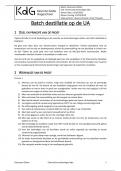Summary
Summary Unit 3.1.1 - Atomic structure
- Institution
- AQA
A detailed summary of the A level AQA Chemistry topic, Atomic Structure. Definitions and equations given in an easy and understandable way. Goes into detail about atoms, isotopes, electronic configurations, ionisation energies and mass spectrometry.
[Show more]












